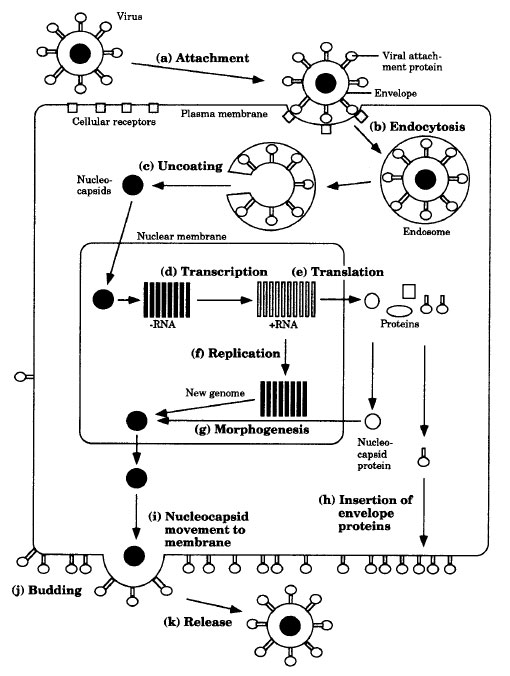Animal Viruses
An overview of eukaryotic viral infection is illustrated in Figure 10-1. For most animal viruses, the first step toward proliferation is attachment (or adsorption) to the surface of a host cell. This is mediated by specific proteins associated with the capsid or envelope, referred to as viral binding sites or viral attachment proteins. The attachment proteins interact with specific proteins or polysaccharides on the surface of the host cell. The proteins on the host cell are called receptors. The specificity of viral attachment proteins and of the host receptors determine to which host cells viruses can adsorb and subsequently infect.Once viruses have attached, they penetrate across the host cell's plasma membrane by either endocytosis or membrane fusion. In endocytosis, viruses enter the cytoplasm within endosomes derived from the invagination of the plasma membrane. Alowering of pH in endosomes is frequently the trigger that leads to capsid disintegration and nucleic acid release, a process known as uncoating. The genomes of most DNA viruses find their way to the nucleus by an unknown mechanism. In the nucleus, the genome is replicated. The RNA viruses generally replicate in the cytoplasm, but there are exceptions including the unique case of retroviruses, discussed below.
 |
| Figure 10-1 Enveloped viral infection of a eukaryotic cell. |
Once the viral nucleic acid reaches the appropriate compartment, it is transcribed and the transcripts are translated. This usually happens before nucleic acid replication is initiated, since some of the proteins synthesized early in infection play a role in viral nucleic acid replication. Following genome replication, the nucleic acid becomes packaged, the virions are assembled, and then release occurs. In nonenveloped viruses, accumulation of virus particles in the cytoplasm causes the host cell to rupture. Assembly of enveloped viruses is closely tied to their release. Nucleocapsids binding to viral proteins in the plasma membrane trigger budding, resulting in enveloped virions.
The replication of the nucleic acid is extremely diverse, however, some general features can be outlined. Single-stranded +RNA viruses, such as picornviruses and togaviruses, maybe directly translated. Aviralencoded RNA-dependent RNApolymerase is produced early on and catalyzes the transcription of intermediate complementary -RNA strands. The minus strands then serve as templates for the synthesis of genomic +RNAs.
Retroviruses are an unusual group of +RNAviruses in that they synthesize new +RNA using a DNA template. The plus genome is converted in a step-wise manner to a dsDNA molecule by reverse transcriptase, which is carried by the virus. Asecond enzyme, ribonuclease H, digests the RNA in the intermediate RNA-DNA hybrid. Reverse transcriptase subsequently synthesizes a DNA strand complementary to the first and the resulting dsDNA integrates into the host genome.
Single-stranded -RNA viruses are those with nucleic acids (genomes) that cannot be translated. The -RNA strand serves as a template for the synthesis of +RNA that functions as mRNA. Viral proteins translated from the mRNApromote the synthesis of full-length +RNAstrands that function as templates for the synthesis of full-length -RNA genome strands. Usually the virus brings into the cell an RNA-dependent RNA polymerase for making viral mRNA.
Examples of - RNA viral diseases:
Influenza
Measles
Meningitis
Hemorrhagic fever
Rabies
Double-stranded RNA viruses, such as reoviruses, are segmented and carry a dsRNA-dependent RNA polymerase which they use to transcribe their genomes. The RNAsegments and the mRNAmolecules specified by them only encode for one protein each. These viruses replicate their dsRNAgenomes by producing many copies of plus strand RNAthat are not translated, but serve as templates for the synthesis of complementary minus strands.
Single-stranded DNA viruses are unusual in that that may have either sense or antisense DNA . Sense DNA can serve as a template for mRNAsynthesis, whereas antisense DNA is unable to function as such a template. Sense DNA can be transcribed immediately, but antisense DNA must serve as the template for the synthesis of the sense strand.
The dsDNA viruses can be divided into two categories: those that replicate their DNA in the host's nucleus and those that replicate entirely in the host's cytoplasm (the poxviruses). Although there are differences in the processes of replication, generally, the viral DNA has to be transcribed and viral proteins synthesized for DNA replication to occur.
Examples of dsDNA viruses:
Adenoviruses
Herpesviruses
Papillomaviruses
Poxviruses
Notes
HIV, which causes AIDS, is a retrovirus.




